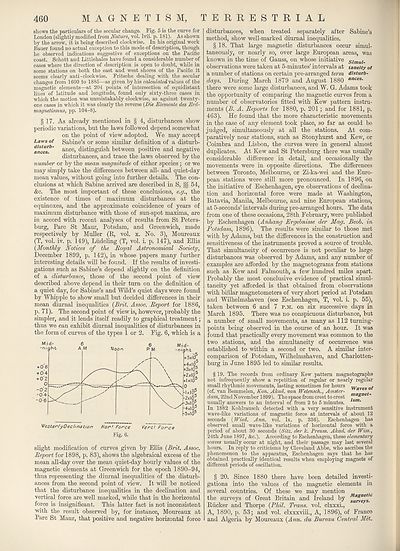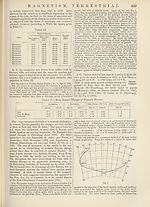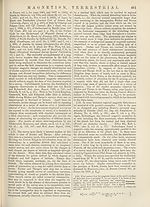New volumes of the Encyclopædia Britannica > Volume 30, K-MOR
(490) Page 460
Download files
Complete book:
Individual page:
Thumbnail gallery: Grid view | List view

460 MAGNETISM, TERRESTRIAL
shows the particulars of the secular change. Fig. 5 is the curve for
London (slightly modified from Nature, vol. Ivii. p. 181). As shown
by the arrow, it is being described clockwise. In his original work
Bauer found no actual exception to this mode of description, though
he observed indications suggestive of exceptions on the Pacific
coast. Schott and Littlehales have found a considerable number of
cases where the direction of description is open to doubt, while in
some stations on both the east and west shores of the Pacific it
seems clearly anti-clockwise. Fritsche dealing with the secular
changes from 1600 to 1885—as given by his calculated values of the
magnetic elements—at 204 points of intersection of equidistant
lines of latitude and longitude, found only sixty-three cases in
which the motion was unmistakably clockwise, as against twenty-
one cases in which it was clearly the reverse [Die Elemente des Erd-
magnetismus, pp. 104-8).
§ 17. As already mentioned in § 4, disturbances show
periodic variations, but the laws followed depend somewhat
on the point of view adopted. We may accept
Laws of Sabine’s or some similar definition of a disturb-
ancesb‘ ance> distinguish between positive and negative
disturbances, and trace the laws observed by the
number or by the mean magnitude of either species ; or we
may simply take the differences between all- and quiet-day
mean values, without going into further details. The con¬
clusions at which Sabine arrived are described in S, §§ 54,
&c. The most important of these conclusions, e.g., the
existence of times of maximum disturbances at the
equinoxes, and the approximate coincidence of years of
maximum disturbance with those of sun-spot maxima, are
in accord with recent analyses of results from St Peters¬
burg, Parc St Maur, Potsdam, and Greenwich, made
respectively by Muller (R, vol. x. No. 3), Moureaux
(T, vol. iv. p. 149), Ludeling (T, vol. i. p. 147), and Ellis
{Monthly Notices of the Royal Astronomical Society,
December 1899, p. 142), in whose papers many further
interesting details will be found. If the results of investi¬
gations such as Sabine’s depend slightly on the definition
of a disturbance, those of the second point of view
described above depend in their turn on the definition of
a quiet day, for Sabine’s and Wild’s quiet days were found
by Whipple to show small but decided differences in their
mean diurnal inequalities {Brit. Assoc. Report for 1886,
p. 71). The second point of view is, however, probably the
simpler, and it lends itself readily to graphical treatment;
thus we can exhibit diurnal inequalities of disturbances in
the form of curves of the types 1 or 2. Fig. 6, which is a
Wester/yDec//nat/on Hor‘ Force Vert' Force
Fig. 6.
slight modification of curves given by Ellis {Brit. Assoc.
Report for 1898, p. 83), shows the algebraical excess of the
mean all-day over the mean quiet-day hourly values of the
magnetic elements at Greenwich for the epoch 1890-94,
thus representing the diurnal inequalities of the disturb¬
ances from the second point of view. It will be noticed
that the disturbance inequalities in the declination and
vertical force are well marked, while that in the horizontal
force is insignificant. This latter fact is not inconsistent
with the result observed by, for instance, Moureaux at
Parc St Maur, that positive and negative horizontal force
disturbances, when treated separately after Sabine’s
method, show well-marked diurnal inequalities.
§ 18. That large magnetic disturbances occur simul¬
taneously, or nearly so, over large European areas, was
known in the time of Gauss, on whose initiative simulm
observations were taken at 5-minutes’ intervals at taneity of
a number of stations on certain pre-arranged term disturb-
days. During March 1879 and August 1880 aaces‘
there were some large disturbances, and W. G. Adams took
the opportunity of comparing the magnetic curves from a
number of observatories fitted with Kew pattern instru¬
ments {B. A. Reports for 1880, p. 201; and for 1881, p.
463). He found that the more characteristic movements
in the case of any element took place, so far as could be
judged, simultaneously at all the stations. At com¬
paratively near stations, such as Stony hurst and Kew, or
Coimbra and Lisbon, the curves were in general almost
duplicates. At Kew and St Petersburg there was usually
considerable difference in detail, and occasionally the
movements were in opposite directions. The differences
between Toronto, Melbourne, or Zi-ka-wei and the Euro¬
pean stations were still more pronounced. In 1896, on
the initiative of Eschenhagen, eye observations of declina¬
tion and horizontal force were made at Washington,
Batavia, Manila, Melbourne, and nine European stations,
at 5-seconds’ intervals during pre-arranged hours. The data
from one of these occasions, 28th February, were published
by Eschenhagen {Anhang Ergebnisse der Mag. Beob. in
Potsdam, 1896). The results were similar to those met
with by Adams, but the differences in the construction and
sensitiveness of the instruments proved a source of trouble.
That simultaneity of occurrence is not peculiar to large
disturbances was observed by Adams, and any number of
examples are afforded by the magnetograms from stations
such as Kew and Falmouth, a few hundred miles apart.
Probably the most conclusive evidence of practical simul¬
taneity yet afforded is that obtained from observations
with bifilar magnetometers of very short period at Potsdam
and Wilhelmshaven (see Eschenhagen, T, vol. i. p. 55),
taken between 6 and 7 p.m. on six successive days in
March 1895. There was no conspicuous disturbance, but
a number of small movements, as many as 112 turning-
points being observed in the course of an hour. It was
found that practically every movement was common to the
two stations, and the simultaneity of occurrence was
established to within a second or two. A similar inter¬
comparison of Potsdam, Wilhelmshaven, and Charlotten-
burg in June 1895 led to similar results.
§ 19. The records from ordinary Kew pattern magnetographs
not infrequently show a repetition of regular or nearly regular
small rhythmic movements, lasting sometimes for hours y/aves of
(of. van Bemmelen, Kon. Akad. van Wetensch., Amster- .
dam, 22ndKovemher 1899). The space from crest to crest aia^ne m
usually answers to an interval of from 2 to 5 minutes. ism"
In 1882 Kohlrausch detected with a very sensitive instrument
wave-like variations of magnetic force at intervals of about 12
seconds (JFied. Ann. vol. lx. p. 336). Eschenhagen has
observed small wave-like variations of horizontal force with a
period of about 30 seconds (Sitz. der k. Preuss. Akad. der Wiss.,
24th June 1897, &c.). According to Eschenhagen, these elementary
waves usually occur at night, and their passage may last several
hours. In reply to criticisms by Cleveland Abbe, who ascribes the
phenomenon to the apparatus, Eschenhagen says that he has
obtained practically identical results when employing magnets of
different periods of oscillation.
§ 20. Since 1880 there have been detailed investi¬
gations into the values of the magnetic elements in
several countries. Of these we may mention
the surveys of Great Britain and Ireland by
Rucker and Thorpe {Phil. Trans, vol. clxxxi.,
A, 1890, p. 53; and vol. clxxxviii., A, 1896), of France
and Algeria by Moureaux {Ann. du Bureau Central Met,
shows the particulars of the secular change. Fig. 5 is the curve for
London (slightly modified from Nature, vol. Ivii. p. 181). As shown
by the arrow, it is being described clockwise. In his original work
Bauer found no actual exception to this mode of description, though
he observed indications suggestive of exceptions on the Pacific
coast. Schott and Littlehales have found a considerable number of
cases where the direction of description is open to doubt, while in
some stations on both the east and west shores of the Pacific it
seems clearly anti-clockwise. Fritsche dealing with the secular
changes from 1600 to 1885—as given by his calculated values of the
magnetic elements—at 204 points of intersection of equidistant
lines of latitude and longitude, found only sixty-three cases in
which the motion was unmistakably clockwise, as against twenty-
one cases in which it was clearly the reverse [Die Elemente des Erd-
magnetismus, pp. 104-8).
§ 17. As already mentioned in § 4, disturbances show
periodic variations, but the laws followed depend somewhat
on the point of view adopted. We may accept
Laws of Sabine’s or some similar definition of a disturb-
ancesb‘ ance> distinguish between positive and negative
disturbances, and trace the laws observed by the
number or by the mean magnitude of either species ; or we
may simply take the differences between all- and quiet-day
mean values, without going into further details. The con¬
clusions at which Sabine arrived are described in S, §§ 54,
&c. The most important of these conclusions, e.g., the
existence of times of maximum disturbances at the
equinoxes, and the approximate coincidence of years of
maximum disturbance with those of sun-spot maxima, are
in accord with recent analyses of results from St Peters¬
burg, Parc St Maur, Potsdam, and Greenwich, made
respectively by Muller (R, vol. x. No. 3), Moureaux
(T, vol. iv. p. 149), Ludeling (T, vol. i. p. 147), and Ellis
{Monthly Notices of the Royal Astronomical Society,
December 1899, p. 142), in whose papers many further
interesting details will be found. If the results of investi¬
gations such as Sabine’s depend slightly on the definition
of a disturbance, those of the second point of view
described above depend in their turn on the definition of
a quiet day, for Sabine’s and Wild’s quiet days were found
by Whipple to show small but decided differences in their
mean diurnal inequalities {Brit. Assoc. Report for 1886,
p. 71). The second point of view is, however, probably the
simpler, and it lends itself readily to graphical treatment;
thus we can exhibit diurnal inequalities of disturbances in
the form of curves of the types 1 or 2. Fig. 6, which is a
Wester/yDec//nat/on Hor‘ Force Vert' Force
Fig. 6.
slight modification of curves given by Ellis {Brit. Assoc.
Report for 1898, p. 83), shows the algebraical excess of the
mean all-day over the mean quiet-day hourly values of the
magnetic elements at Greenwich for the epoch 1890-94,
thus representing the diurnal inequalities of the disturb¬
ances from the second point of view. It will be noticed
that the disturbance inequalities in the declination and
vertical force are well marked, while that in the horizontal
force is insignificant. This latter fact is not inconsistent
with the result observed by, for instance, Moureaux at
Parc St Maur, that positive and negative horizontal force
disturbances, when treated separately after Sabine’s
method, show well-marked diurnal inequalities.
§ 18. That large magnetic disturbances occur simul¬
taneously, or nearly so, over large European areas, was
known in the time of Gauss, on whose initiative simulm
observations were taken at 5-minutes’ intervals at taneity of
a number of stations on certain pre-arranged term disturb-
days. During March 1879 and August 1880 aaces‘
there were some large disturbances, and W. G. Adams took
the opportunity of comparing the magnetic curves from a
number of observatories fitted with Kew pattern instru¬
ments {B. A. Reports for 1880, p. 201; and for 1881, p.
463). He found that the more characteristic movements
in the case of any element took place, so far as could be
judged, simultaneously at all the stations. At com¬
paratively near stations, such as Stony hurst and Kew, or
Coimbra and Lisbon, the curves were in general almost
duplicates. At Kew and St Petersburg there was usually
considerable difference in detail, and occasionally the
movements were in opposite directions. The differences
between Toronto, Melbourne, or Zi-ka-wei and the Euro¬
pean stations were still more pronounced. In 1896, on
the initiative of Eschenhagen, eye observations of declina¬
tion and horizontal force were made at Washington,
Batavia, Manila, Melbourne, and nine European stations,
at 5-seconds’ intervals during pre-arranged hours. The data
from one of these occasions, 28th February, were published
by Eschenhagen {Anhang Ergebnisse der Mag. Beob. in
Potsdam, 1896). The results were similar to those met
with by Adams, but the differences in the construction and
sensitiveness of the instruments proved a source of trouble.
That simultaneity of occurrence is not peculiar to large
disturbances was observed by Adams, and any number of
examples are afforded by the magnetograms from stations
such as Kew and Falmouth, a few hundred miles apart.
Probably the most conclusive evidence of practical simul¬
taneity yet afforded is that obtained from observations
with bifilar magnetometers of very short period at Potsdam
and Wilhelmshaven (see Eschenhagen, T, vol. i. p. 55),
taken between 6 and 7 p.m. on six successive days in
March 1895. There was no conspicuous disturbance, but
a number of small movements, as many as 112 turning-
points being observed in the course of an hour. It was
found that practically every movement was common to the
two stations, and the simultaneity of occurrence was
established to within a second or two. A similar inter¬
comparison of Potsdam, Wilhelmshaven, and Charlotten-
burg in June 1895 led to similar results.
§ 19. The records from ordinary Kew pattern magnetographs
not infrequently show a repetition of regular or nearly regular
small rhythmic movements, lasting sometimes for hours y/aves of
(of. van Bemmelen, Kon. Akad. van Wetensch., Amster- .
dam, 22ndKovemher 1899). The space from crest to crest aia^ne m
usually answers to an interval of from 2 to 5 minutes. ism"
In 1882 Kohlrausch detected with a very sensitive instrument
wave-like variations of magnetic force at intervals of about 12
seconds (JFied. Ann. vol. lx. p. 336). Eschenhagen has
observed small wave-like variations of horizontal force with a
period of about 30 seconds (Sitz. der k. Preuss. Akad. der Wiss.,
24th June 1897, &c.). According to Eschenhagen, these elementary
waves usually occur at night, and their passage may last several
hours. In reply to criticisms by Cleveland Abbe, who ascribes the
phenomenon to the apparatus, Eschenhagen says that he has
obtained practically identical results when employing magnets of
different periods of oscillation.
§ 20. Since 1880 there have been detailed investi¬
gations into the values of the magnetic elements in
several countries. Of these we may mention
the surveys of Great Britain and Ireland by
Rucker and Thorpe {Phil. Trans, vol. clxxxi.,
A, 1890, p. 53; and vol. clxxxviii., A, 1896), of France
and Algeria by Moureaux {Ann. du Bureau Central Met,
Set display mode to:
![]() Universal Viewer |
Universal Viewer | ![]() Mirador |
Large image | Transcription
Mirador |
Large image | Transcription
Images and transcriptions on this page, including medium image downloads, may be used under the Creative Commons Attribution 4.0 International Licence unless otherwise stated. ![]()
| Encyclopaedia Britannica > New volumes of the Encyclopædia Britannica > Volume 30, K-MOR > (490) Page 460 |
|---|
| Permanent URL | https://digital.nls.uk/193573871 |
|---|
| Attribution and copyright: |
|
|---|---|
| Shelfmark | EB.18 |
|---|---|
| Description | Ten editions of 'Encyclopaedia Britannica', issued from 1768-1903, in 231 volumes. Originally issued in 100 weekly parts (3 volumes) between 1768 and 1771 by publishers: Colin Macfarquhar and Andrew Bell (Edinburgh); editor: William Smellie: engraver: Andrew Bell. Expanded editions in the 19th century featured more volumes and contributions from leading experts in their fields. Managed and published in Edinburgh up to the 9th edition (25 volumes, from 1875-1889); the 10th edition (1902-1903) re-issued the 9th edition, with 11 supplementary volumes. |
|---|---|
| Additional NLS resources: |
|

